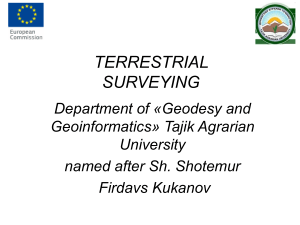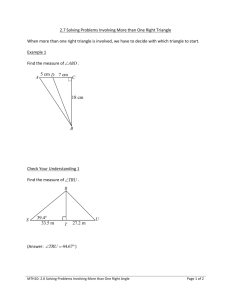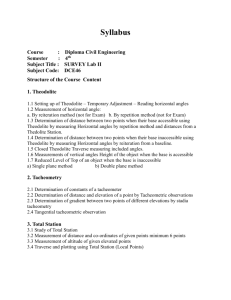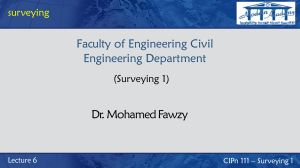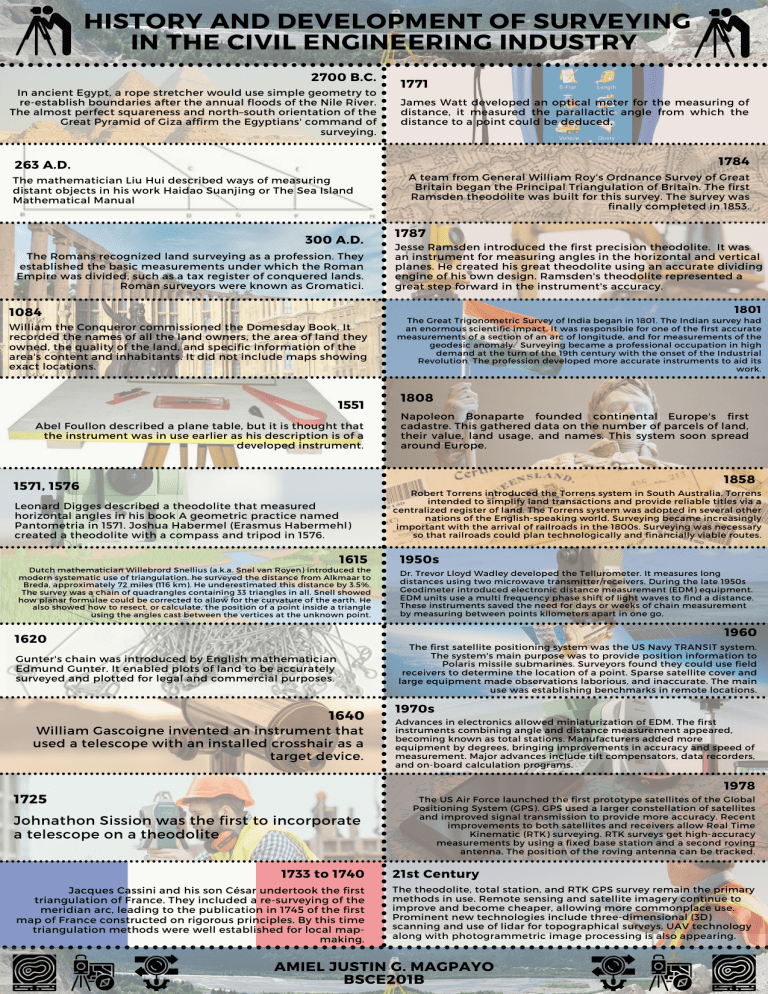
HISTORY AND DEVELOPMENT OF SURVEYING IN THE CIVIL ENGINEERING INDUSTRY 2700 B.C. In ancient Egypt, a rope stretcher would use simple geometry to re-establish boundaries after the annual floods of the Nile River. The almost perfect squareness and north–south orientation of the Great Pyramid of Giza affirm the Egyptians' command of surveying. 1771 James Watt developed an optical meter for the measuring of distance, it measured the parallactic angle from which the distance to a point could be deduced. 1784 263 A.D. The mathematician Liu Hui described ways of measuring distant objects in his work Haidao Suanjing or The Sea Island Mathematical Manual 300 A.D. The Romans recognized land surveying as a profession. They established the basic measurements under which the Roman Empire was divided, such as a tax register of conquered lands. Roman surveyors were known as Gromatici. A team from General William Roy's Ordnance Survey of Great Britain began the Principal Triangulation of Britain. The first Ramsden theodolite was built for this survey. The survey was finally completed in 1853. 1787 Jesse Ramsden introduced the first precision theodolite. It was an instrument for measuring angles in the horizontal and vertical planes. He created his great theodolite using an accurate dividing engine of his own design. Ramsden's theodolite represented a great step forward in the instrument's accuracy. 1801 1084 William the Conqueror commissioned the Domesday Book. It recorded the names of all the land owners, the area of land they owned, the quality of the land, and specific information of the area's content and inhabitants. It did not include maps showing exact locations. 1551 Abel Foullon described a plane table, but it is thought that the instrument was in use earlier as his description is of a developed instrument. The Great Trigonometric Survey of India began in 1801. The Indian survey had an enormous scientific impact. It was responsible for one of the first accurate measurements of a section of an arc of longitude, and for measurements of the geodesic anomaly. Surveying became a professional occupation in high demand at the turn of the 19th century with the onset of the Industrial Revolution. The profession developed more accurate instruments to aid its work. 1808 Napoleon Bonaparte founded continental Europe's first cadastre. This gathered data on the number of parcels of land, their value, land usage, and names. This system soon spread around Europe. 1858 1571, 1576 Leonard Digges described a theodolite that measured horizontal angles in his book A geometric practice named Pantometria in 1571. Joshua Habermel (Erasmus Habermehl) created a theodolite with a compass and tripod in 1576. 1615 Dutch mathematician Willebrord Snellius (a.k.a. Snel van Royen) introduced the modern systematic use of triangulation. he surveyed the distance from Alkmaar to Breda, approximately 72 miles (116 km). He underestimated this distance by 3.5%. The survey was a chain of quadrangles containing 33 triangles in all. Snell showed how planar formulae could be corrected to allow for the curvature of the earth. He also showed how to resect, or calculate, the position of a point inside a triangle using the angles cast between the vertices at the unknown point. Robert Torrens introduced the Torrens system in South Australia. Torrens intended to simplify land transactions and provide reliable titles via a centralized register of land. The Torrens system was adopted in several other nations of the English-speaking world. Surveying became increasingly important with the arrival of railroads in the 1800s. Surveying was necessary so that railroads could plan technologically and financially viable routes. 1950s Dr. Trevor Lloyd Wadley developed the Tellurometer. It measures long distances using two microwave transmitter/receivers. During the late 1950s Geodimeter introduced electronic distance measurement (EDM) equipment. EDM units use a multi frequency phase shift of light waves to find a distance. These instruments saved the need for days or weeks of chain measurement by measuring between points kilometers apart in one go. 1960 1620 Gunter's chain was introduced by English mathematician Edmund Gunter. It enabled plots of land to be accurately surveyed and plotted for legal and commercial purposes. 1640 William Gascoigne invented an instrument that used a telescope with an installed crosshair as a target device. The first satellite positioning system was the US Navy TRANSIT system. The system's main purpose was to provide position information to Polaris missile submarines. Surveyors found they could use field receivers to determine the location of a point. Sparse satellite cover and large equipment made observations laborious, and inaccurate. The main use was establishing benchmarks in remote locations. 1970s Advances in electronics allowed miniaturization of EDM. The first instruments combining angle and distance measurement appeared, becoming known as total stations. Manufacturers added more equipment by degrees, bringing improvements in accuracy and speed of measurement. Major advances include tilt compensators, data recorders, and on-board calculation programs. 1978 1725 Johnathon Sission was the first to incorporate a telescope on a theodolite 1733 to 1740 Jacques Cassini and his son César undertook the first triangulation of France. They included a re-surveying of the meridian arc, leading to the publication in 1745 of the first map of France constructed on rigorous principles. By this time triangulation methods were well established for local mapmaking. The US Air Force launched the first prototype satellites of the Global Positioning System (GPS). GPS used a larger constellation of satellites and improved signal transmission to provide more accuracy. Recent improvements to both satellites and receivers allow Real Time Kinematic (RTK) surveying. RTK surveys get high-accuracy measurements by using a fixed base station and a second roving antenna. The position of the roving antenna can be tracked. 21st Century The theodolite, total station, and RTK GPS survey remain the primary methods in use. Remote sensing and satellite imagery continue to improve and become cheaper, allowing more commonplace use. Prominent new technologies include three-dimensional (3D) scanning and use of lidar for topographical surveys. UAV technology along with photogrammetric image processing is also appearing. AMIEL JUSTIN G. MAGPAYO BSCE201B

